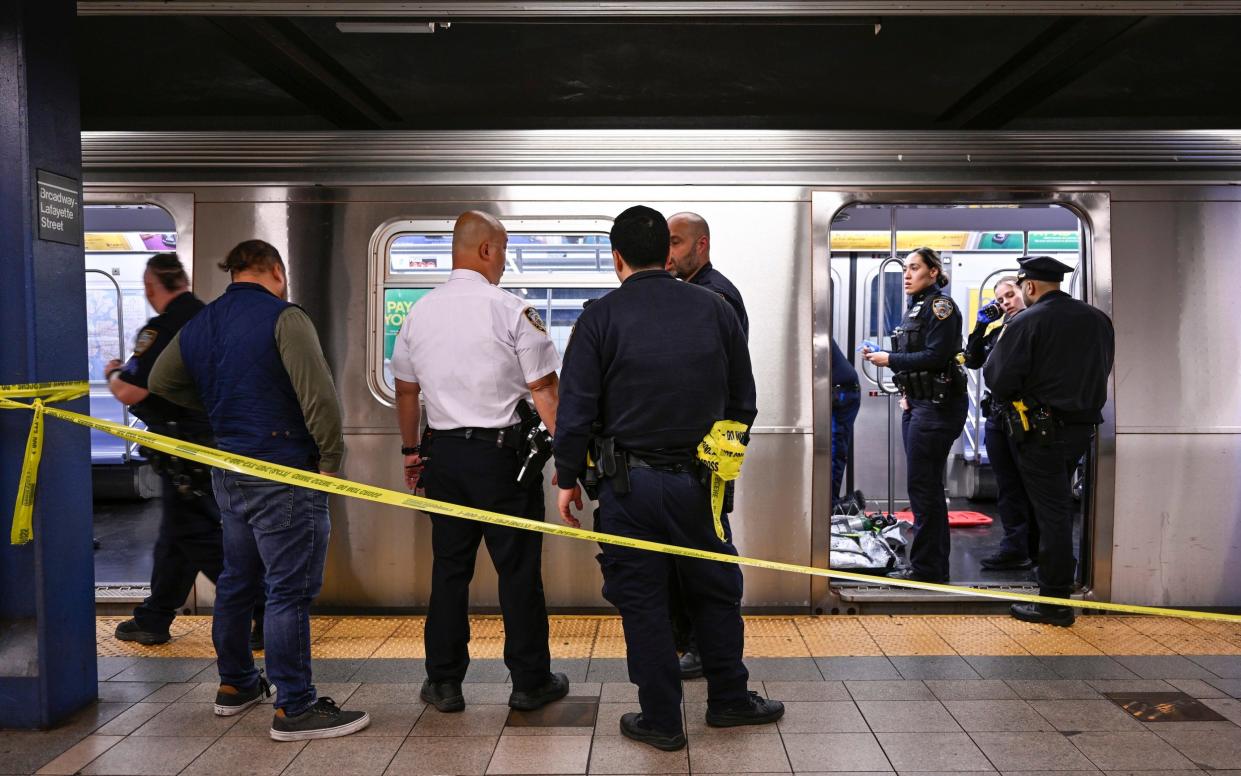America's cities have become horror stories of crime, dirt and death

- Oops!Something went wrong.Please try again later.
Growing up on the East Coast of America, there was always something quite exciting about its cities: we had Boston a short drive to the south – which, with the glinting glass skyscrapers of its financial centre, felt sharp and busy and dynamic.
New York, a four hour drive away, was like a forcefield of urban energy: packed with exotic, wonderful shops; wafting with food smells, and with a subway whose subterranean ugliness didn’t stop it – after the city was cleaned up in the 1990s – from operating briskly and at capacity, ferrying about a fascinating array of people. New York seemed to be – and looked like – the centre of the world.
Since then, not only have America’s great cities lost their sheen, sparkle, energy and excitement – the forces of chaos and disorder have engulfed them.
The latest crisis to bury New York is the arrival of far more migrants – the city has a law that requires the provision of shelter to all migrants in a timely fashion – than it can possibly manage or pay for.
“If we don’t get the support we need, New Yorkers could be left with a $12 billion bill,” said the city’s mayor Eric Adams last week. This is a significant portion of the city’s current budget of $107 billion; the NYPD’s budget this year is only $5.8 billion.
Already new arrivals have been forced to sleep in the streets and residents – including pop star Lady Gaga’s father – are complaining of appalling mismanagement in how the newcomers are being settled.
Buildings like the Stratford Arms Hotel, once a residence hall for the American Musical and Dramatic Academy, have been transformed into dormitories. Locals have complained that the roads nearby are now full of rubbish, and that there are rising levels of street harassment and noise throughout the night.
“The immigration system in this nation is broken; it has been broken for decades,” Adams said. “Today, New York City has been left to pick up the pieces.”
There is, of course, some truth to this: America has shown itself to be contradictory and inefficient, cruel and chaotic, in its handling of immigrants, many of them illegal migrants who have crossed its southern border from Mexico.
But it’s not entirely America’s fault that New York is “left to pick up the pieces”: the country’s cities have become island behemoths overrun by inefficiency and politicised local rule – much of it painfully, dangerously woke – and have always run on a track quite divorced from the rest.
But New York is grappling with far more severe problems than the soaring cost of the country’s migrant crisis. Its subway system is broken and dangerous, law enforcement is untrustworthy and selective, and the air quality in its underground stations was found by one study to be as bad as above ground during the recent crisis over wildfire smoke.
Many of New York’s streets are filthy. Rats and cockroaches continue to plague the city.
Crime rates have soared – as in most other American cities. But in places like New York and San Francisco, that surge in crime also revealed something just as frightening: a woke-rotted criminal justice system; a police force missing in action because they had essentially been incentivised to let crimes go unpunished for fear of falling foul of social justice dogma, amid worrying calls to “defund the police”.
Although America’s most dangerous cities are clustered in the south and mid-west, with Memphis at the top, and others including St Louis and Detroit, the formerly idyllic West and Pacific North West coasts provide perhaps the most dystopian spectacles of all.
Homelessness has surged in LA to an estimated 75,000, with many people now living in tents and cars. Seattle and San Francisco are also full of homeless encampments: tents stretching along roads, a constant reminder of the hideous malfunctioning in the management of those cities.
America, once the land of hope and glory, its cities beacons where anyone could make it with a bit of hard work, is now a land of metropolises balkanised between the very rich and the destitute, drug-addled poor.
The trends are horrifying: in Seattle, overdose deaths rose 72 per cent from 2021 to 2022, with most due to fentanyl and methamphetamines. Deaths from fentanyl and other opioids also plague San Francisco.
Meanwhile, the Bay Area has become famous for something else: unbridled, unpunished crime, while its woke policymakers care so much about pushing their agenda that state schools prioritise social justice issues over literacy and basic numeracy, in which failure rates are soaring among nine year olds and up.
We hear much of “the two Americas” – the coastal urban rich and everyone else.
But a new division, perhaps a truer one, has emerged: between America’s dysfunctional cities, full of dirt and poverty and crime, hobbled by corruption, and the rest of the country, which, thanks to a rich array of civic groups, funding systems and local councilors, appears to be doing ok.
I am currently laying low in a coastal town in Massachusetts. In previous years, I may have relished visiting a city or two, but now you’d have to pay me to leave small town America for the not-so-bright lights of the sprawling city.

